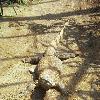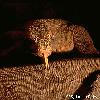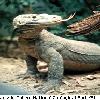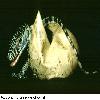
 |
 |  |  |
|
WATER DRAGONS
KOMODO DRAGONS |
Dragons will always live on the Earth, we do have real dragons here! There is even a genus of lizard called draco. Two "dragon" lizards are water dragons, and Komodo dragons. The water dragon is a popular small lizard to keep as pets. The Komodo dragon (not discovered until 1912!) is the largest known lizard today, reaching lengths of 10 feet, and 150 pounds. The bright yellow tongue could be mistaken for a flame, and its vicious nature would scare anyone away.
Some other "dragons" are the Dragonfly, and the Snapdragon flower. The Dragonfly could have been mistaken for a small flying dragon in the past, although, in Jurassic times, Dragonflies were as big as a seagull. The Snapdragon flower looks like a red mouth with a gaping yellow throat, which could be where it's name came from.
Komodo Dragons
For all those non-believers out there, there is at least one dragon we can prove the existence of.. the Komodo dragon (Varanus komodoensis). This magnificent reptile can attain a length of 10 feet and a weight of 300 pounds, making it the world's largest living lizard. Komodo dragons occur only on the Indonesian islands of Komodo, Rintja, Padar, Flores, Gili, Mota and Owadi Sami which are located about 200 miles south of Bali. Their habitat includes lowland and semi-arid, hot savannah areas, mainly open with grasslands and palm trees. Description and longevity Although their color may vary, they are normally a sandy brown with mottled dark and yellow markings. Although they may reach 10 feet, a typical well-fed adult male measures 8.6 feet in length and weighs 200 pounds, a typical female 7.6 feet and 150 pounds. They have a large yellow forked tongue and their lower jaw bones can separate to accommodate large prey items. Their extremely short and powerful legs are armed with strong, sharp claws which can be used in self defense quite effectively. The massive tail, which is longer than the body can deliver powerful crushing blows. Average known lifespan is about 20 years.
Habits Diurnal in nature, Komodo dragons start hunting at about 6:00 am. They rely on an ambush and grab method to capture prey, but if this fails, they can run up to 22 km/h for short periods. They prefer to hunt deer, goat and wild boar although they also hunt buffalo, horses, reptiles (including smaller Komodos), sea turtle eggs, carrion, and monkeys, but are quite happy eating carrion. It has been documented that Komodo's have attacked people, but this is extremely rare. Their keen eyesight and excellent climbing skills even allow them to hunt birds or feed on their eggs. Their prey is usually swallowed whole unless other nearby dragons get in on the action. An opening at the base of the tongue allows them breathe during the lengthy process of swallowing something as large as a deer. Sometimes prey may escape, but the bacteria present in the saliva can cause complications resulting in the death of the animal over the next couple of days. With their keen sense of smell afforded to them by the Jacobson's organ, Komodos can track an injured animal as far as 4 miles away. They are so carnivorous in nature, that they have been known to reject the stomach contents of herbivorous animals. Although solitary in nature, these dragons will use the leverage provided by their fellows to tear apart large prey. Excellent swimmers, their endurance allows them to swim to nearby islands when food is scarce. Young:
Like the crocodilian family, Komodos guard their nests till the eggs hatch. They lay between 17-40 eggs into a hole that they have dug then cover them up. During this time, the dragon will not feed. The reason Komodos protect their eggs is because of the carnivores nature of their species. A dragon on the prowl could easily sniff out the incubating eggs, dig them up and have a nice Komodo egg dinner. If it was not for the mother guarding the nest, it is quite possible that dragons would be extent right now. A female guarding her eggs is not something you wish to tangle with, fearlessly attacking anything that ventures to close. After the 7-8 month incubation period, young dragons start to hatch, using their egg tooth at the tip of their snouts to cut through the leathery shell.
Other:
The Komodo dragon is an endangered species. Since 1982, captive breeding, like that at the Smithsonian's National Zoological Park (NZP), has increased the number of dragons by 157. The current population of Komodo dragons seems relatively stable at about 5,000 animals, yet scientists are concerned that only 350 of them are breeding females. This may be a normal sex ratio; little is known about the species. The dragon's limited distribution makes them highly susceptible to natural or human-caused events, such as storms, fire, or disease. In the last few years, Zoos have been jumping in with both feet to help the dragons. There are now 27 zoos in the United States alone who have Komodos! With any luck, breeding will increase so much so we can re introduce dragons back to the wild in numbes so great, they no longer will be endangered. Komodo dragons are CITIES protected.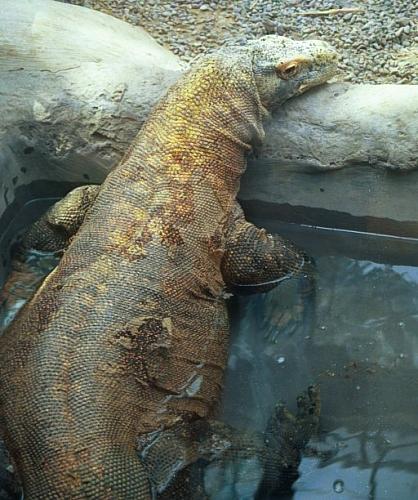
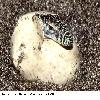 They are about 9" when hatched. They emeatly take to the trees where they will live for 2 years, feeding on geckos, insects, frogs, or anything else they can overpower and devour. At the end of the 2nd year, the young dragons will start to venture out of their tree homes, but only for short periods at a time.
They are about 9" when hatched. They emeatly take to the trees where they will live for 2 years, feeding on geckos, insects, frogs, or anything else they can overpower and devour. At the end of the 2nd year, the young dragons will start to venture out of their tree homes, but only for short periods at a time.